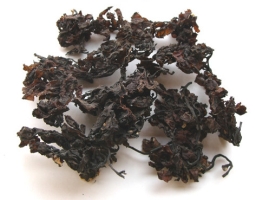- Goiter and scrofula, with
Bombyx
Batryticatus- Jiang can, infected with Batryticatus fungus,
Prunella
vulgaris- Xia ku cao and
Scrophularia
ningpoensis- Xuan shen.
[5]
- Goiter and scrofula, with
Glycyrrhiza
uralensis- Gan cao.
[5]
- Silicosis presenting as Yin deficiency and copious sputum, with
Eleocharis
dulcis- Water chestnuts.
[5]
[1] Barefoot Doctor's Manual- 1977 Prepared by the Revolutionary Health Committee
of Hunan Province. Original Chinese manual- Victor W. Sidel. Originally published
by Dr Joseph Quin and the Fogarty International centre, Bethdesda (1974). Madrona
Publishers Seattle Washington ISBN 0-914842-52-8
[2] A Complete English Dictionary of Medicinal Terms in Chinese Acupuncture
and Herbalism 1981 - Henry Lu Chinese Foundations of Natural Health- The Academy
of Oriental Heritage, Vancouver, Canada.
[3] Chinese System of Food Cures Prevention and Remedies. 1986 Lu, Henry. Sterling
Publishing Co., Inc. New York. USA. Distributed in Australia by Capricorn Book
Co. Pty Ltd. Lane Cove, NSW. ISBN 0-8069-6308-5.
[4] Medicated Diet of Traditional Chinese Medicine - Chief Editor- Hou Jinglun.
Associate Editors- Zhao Xin, Li Weidong, Liu Jianxin, Geng Chun-e, Li Guohua,
Li Shaohua. Geijing. Science & Technology Press 1994. ISBN 7-5304-1735-5/R.
309.
[5] Chinese Herbal Medicine Materia Medica- Dan Bensky and Andrew Gamble- Eastland
Press 1986 Seattle Washington ISBN 0-939616-15-7
Images
1.
oshims.com
2.
tcmwiki.com Alginic acid, mannitol, potassium, iodine,
laminine, sargassan.[5]
References
[1] Chinese Herbal Medicine Materia Medica- Dan Bensky and Andrew Gamble- Eastland
Press 1986 Seattle Washington ISBN 0-939616-15-7
 Sargassum
siliquastrum, S. pallidum, S. fusiforme 海
藻
Hǎi zǎo
Seaweed Family: Sargassaceae
Sargassum
siliquastrum, S. pallidum, S. fusiforme 海
藻
Hǎi zǎo
Seaweed Family: Sargassaceae
